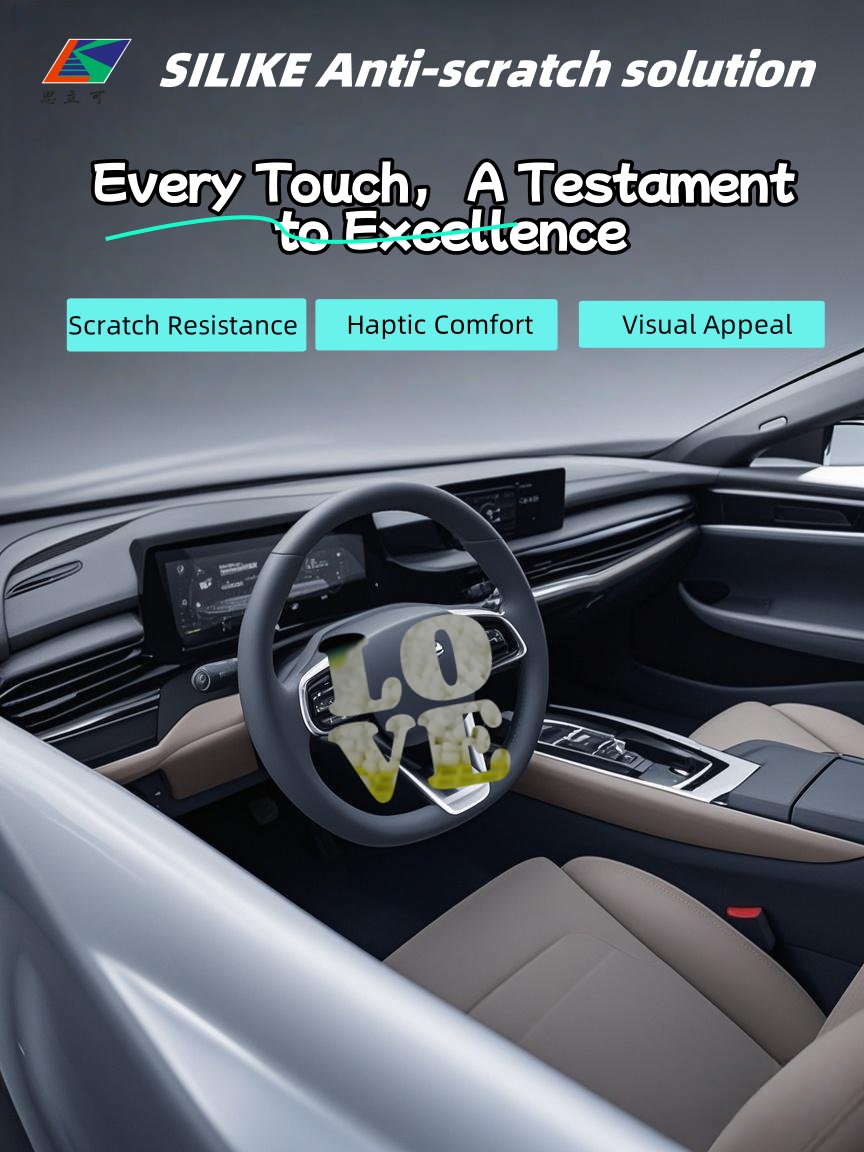Polypropylene (PP) talc compounds are a cornerstone in automotive interior manufacturing, prized for their optimal balance of mechanical performance, processability, and cost-effectiveness. They are extensively used in dashboards, door panels, center consoles, and pillar trims. However, a persistent and significant challenge for automotive compounders and Tier suppliers is achieving durable, long-lasting scratch resistance in these components. Unsightly scratches not only mar the aesthetic appeal but also negatively impact the perceived quality and longevity of the vehicle’s interior. This article delves into the critical pain points faced by the industry and explores how scratch-resistant additives are providing effective, lasting solutions, paving the way for superior automotive interiors.
Common Solutions to Scratch Resistance in Automotive PP Talc Compounds & Their Limitations
1. Surface Coatings (e.g., Clear Coats, Paints):
Advantages: Can provide good initial surface hardness and gloss control.
Drawbacks: Adds significant cost and complexity (extra processing step, VOC emissions, specialized equipment). Durability is a major concern, as coatings can chip, peel, or wear over time. Adhesion to PP can also be challenging.
2. Traditional Fillers & Polymer Blends:
Advantages: Optimizing talc, incorporating other hard fillers (e.g., wollastonite), or blending with more scratch-resistant polymers can offer some improvement.
Drawbacks: Often provides only marginal scratch resistance improvement. Can negatively impact other properties like impact strength or processability. Polymer blending can lead to compatibility issues and significantly increase costs.
3. Migratory Lubricants (e.g., Fatty Acid Amides, Waxes, Basic Silicones):
Advantages: Relatively low cost and can provide some surface slip, reducing the visibility of minor scuffs.
Drawbacks: Their effect is often temporary as they can be wiped off, migrate out excessively (leading to blooming or stickiness, especially after UV/heat exposure), or volatilize. This results in a loss of scratch resistance over time and can interfere with downstream processes like painting or adhesion.
PROVEN SOLUTIONS FOR ANTI-SCRATCH AUTOMOTIVE PP INTERIOR MATERIALS
Since entering the automotive scratch resistance industry in 2013, SILIKE has established itself as a trusted innovator in polymer additive technology. Our long-term scratch-resistant additives are the result of extensive R&D and rigorous real-world validation, delivering proven performance in challenging automotive applications, especially for automotive PP talc interior applications.
What are Long-Lasting Scratch Resistance Additives for Automotive Polypropylene Talc Compounds of SILIKE?
SILIKE’s Anti-Scratch Masterbatch technology offers enhanced compatibility with Polypropylene (CO-PP/HO-PP) matrices, reducing phase segregation on the final surface. This ensures the masterbatch remains on the surface of the plastic without migration or exudation, minimizing fogging, VOCs, or odors. The technology significantly improves the long-lasting anti-scratch properties and durability of automotive interiors, enhancing various aspects such as quality, aging, hand feel, and reduced dust buildup.
Suitable for a range of automotive interior surfaces, including door panels, dashboards, center consoles, instrument panels, glove box doors, and seat trims, where resistance to daily wear and tear is critical.
Positive Feedback from Compounders and Tier Suppliers: Customers report significant improvements in surface durability, reduced manufacturing defects related to surface damage, and enhanced overall part quality when using SILIKE’s anti-scratch solutions
Why SILIKE’s Anti-Scratch Masterbatch is a “Long-Term” Scratch-Resistant Additive
These are not simple silicone additives or oils. They typically involve high molecular weight siloxanes, organo-modified siloxanes, or reactive silicones that form a more permanent, resilient low-friction surface, or even co-react to some extent with the matrix. These additives are usually supplied as masterbatches for easy incorporation.
Key Features of SILIKE’s Scratch-Resistant Additives for Automotive PP-Talc Compounds (e.g., SILIKE Scratch-Resistant Agent LYSI-306H)
1. Seamless Integration & Cost-Efficiency
Easy to Compound – Compatible with existing PP talc compounding processes, requiring no special equipment.
Low Dosage, High Performance – Just 1.0–3.0% loading significantly improves scratch resistance, durability & surface quality while keeping costs competitive.
2. Enhanced Surface Aesthetics & Performance
Superior Scratch Resistance – Minimizes visible scratches & whitening under load (tested per GMW 14688, 10N), Meeting OEM Standards.
Improved Aging Resistance – Maintains surface integrity even after heat/UV exposure.
Premium Hand Feel – Smoother surface texture, enhancing user experience.
Reduced Dust Buildup – Low-friction surface helps repel dust, ideal for automotive interiors (dashboards, door panels, trims).
FAQs – Scratch-Resistant Automotive PP-Talc Compounds
Q1: How do long-term scratch-resistant additives LYSI-306H differ from traditional slip agents or waxes?
A1: Traditional slip agents Amide and waxes are often migratory. SILIKE Anti-scratch Masterbatch LYSI-306H is expected to give a much better scratch resistance, without any migration or exudation
Q2: Will these advanced additives significantly affect the color or gloss of my PP talc compound?
A2: High-quality long-term scratch-resistant additives are formulated to have minimal impact on the natural color and gloss of the compound. However, it is always recommended to test specific formulations, as interactions can occur. Some additives might offer slight gloss modification capabilities.
Q3: What kind of scratch test methods are most relevant for evaluating these anti-scratch additives in automotive PP talc parts?
A3: Common industry tests include the five-finger scratch test (e.g., GMW 14688, PV 3952), cross-hatch scratch tests, and instrumented scratch testers that measure parameters like scratch width, depth, and the force required to scratch. The specific OEM specification will dictate the required test methods.
Q4: Can these additives help reduce or eliminate stress whitening on PP talc parts upon scratching?
A5: Yes, many effective long-term scratch-resistant additives (SILIKE Anti-scratch masterbatch)significantly reduce the visibility of scratches, including minimizing the stress whitening effect that often makes scratches on PP talc compounds more apparent.
Contact SILIKE to overcome scratches on automotive PP talc interior parts. Discover how long-term scratch-resistant additives offer superior durability and aesthetics. Solutions for Compounders in Plastic Formulation.
Post time: May-16-2025






